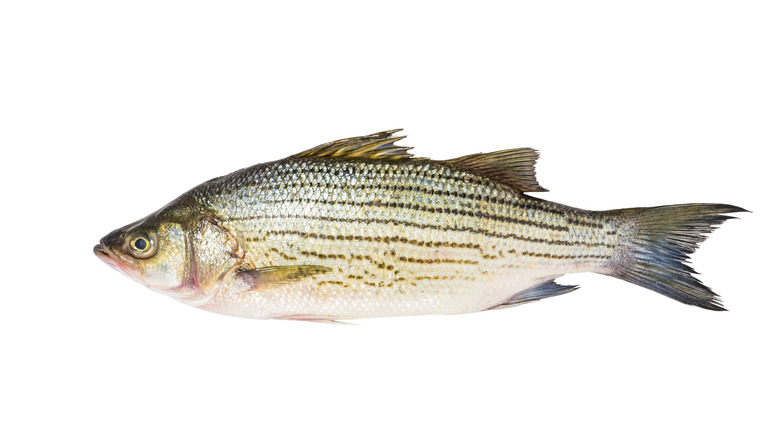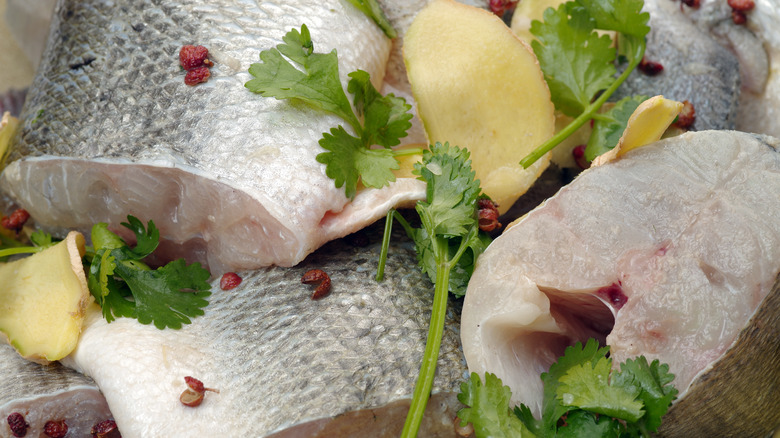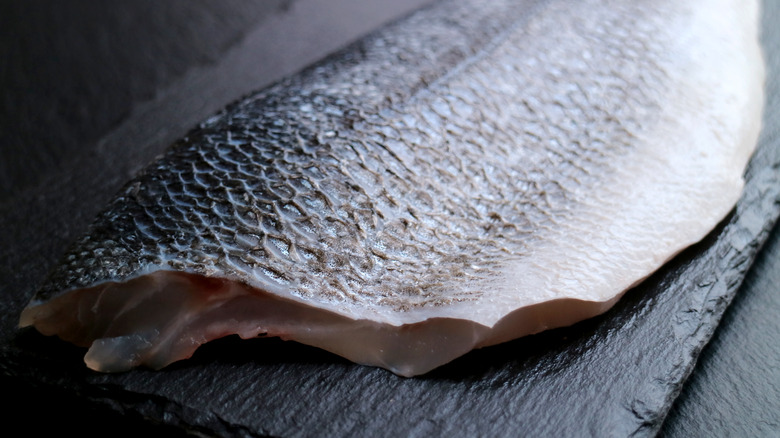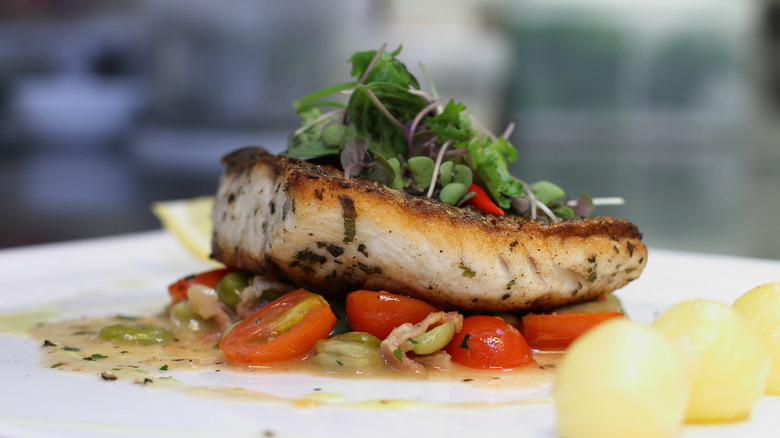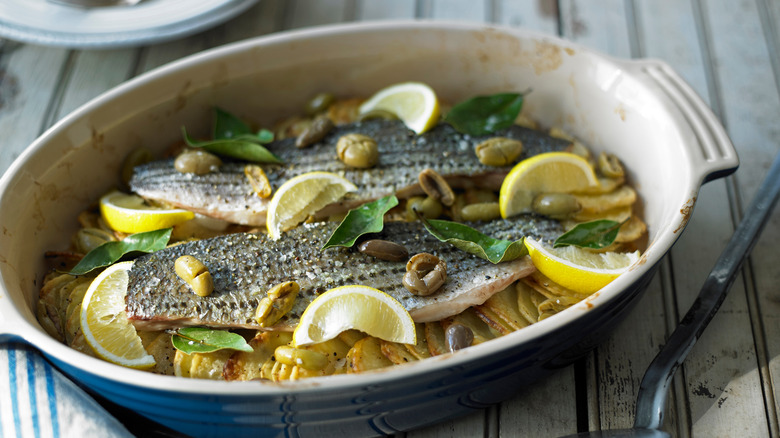What Is Striped Bass And What Does It Taste Like?
You'd be hard-pressed to find a cooking method that doesn't suit the striped bass (aka Morone saxatilis). The fish is popular grilled, poached, smoked, sautéed, broiled, fried — you name it. There's even a school of believers who swear that boiling the mild-tasting, white-fleshed fish results in a consistency that's perfect for creating a mock lobster salad that On the Water describes as a cross between tuna and lobster, in a good way.
Also known as bass, rockfish, striper, and linesider, striped bass are found along the Atlantic coast of North America from the St. Lawrence River in Canada to the St. John's River in Florida and, to a lesser extent, in the Gulf of Mexico along the coasts of Florida and Louisiana (via NOAA). An anadromous species, according to the U.S. Fish & Wildlife Service, striped bass hatch in freshwater tributaries, migrate to the ocean, and then return to spawn in freshwater.
What does striped bass taste like?
Striped bass is one of those "not-too-fishy" fish that even the pickiest eaters can comfortably try — and maybe even like. Its flavor profile is delicate and mild, similar to cod or halibut. When cooked, it takes on a firm, flaky texture with a subtle, slightly sweet flavor that many perceive as buttery, but not oily, due to its fat content.
Sophisticated palates may pick up on differences between farm-raised and wild-caught striped bass. Overfishing in the mid-20th century led to a steep decline in the wild striped bass population, inspiring conservation activists to help the species recover and hatcheries to cultivate farm-raised fish (via National Coalition for Marine Conservation). In addition to slight aesthetic differences between wild and farm-raised fish, wild bass often has a more "robust" flavor, notes Saveur, while farmed fish raised in tanks with powerful filtration systems often get more exercise and take on firmer, flakier flesh.
How to buy striped bass
At the seafood market, look for striped bass fillets or steaks with moist skin, flesh that's firm to the touch, and a pleasant scent. If there's any hint of ammonia, steer clear. When selecting a whole fish, look for bright red gills and check the eyes; if they're discolored or sunken, the fish is past its prime, instructs Fish Choice.
The commercial fishing season for wild striped bass runs from June to December, but farm-raised varieties are available year-round. While farm-raised fish rarely grow beyond 3 pounds (via Saveur), those in the wild can reach 70 pounds or more, and fishing regulations set legal limits on the smallest fish allowed to be caught to ensure sustainability, NOAA explains. The Spruce Eats says striped bass are most flavorful and least full of heavy metals when they are 18 to 36 inches long. Be sure to ask the fishmonger for the collars (the meaty cuts behind the gills) and cheeks — two often overlooked parts of the fish that in-the-know striped bass lovers swear are the tastiest morsels of all.
How to cook striped bass
Striped bass is a versatile fish that adapts easily to a multitude of cooking methods and styles. First-timers may want to start with a fillet, the strip of flesh cut from the side of the fish. Pan-searing over is a quick and easy option. Just melt oil or butter in a skillet and season the fillets with whatever sounds good (such as salt, pepper, garlic, coriander, or oregano). Sear skin-side down for 3 minutes, flip and sear the other side for another 3 minutes, and voila, you have perfectly cooked fish to be paired with any sides you like.
Other ideas include Block Island striped bass with brown butter, lemon, and capers from the James Beard Foundation, as well as Food Network chef Anne Burrell's seared wild striped bass with sautéed spring vegetables. If you prefer to go whole hog — or whole fish in this case — try Alton Brown's whole striped bass from the Cooking Channel, which looks fancy but goes from prep to plate in less than an hour. As you may have noticed, the ideal route for striped bass is simplicity: Minimal ingredients allow this delicate, buttery fish to shine.
Are there different kinds of bass?
"Bass" and "fishing" go hand in hand, but when different people talk about going bass fishing, there's a good chance they're referring to notably different experiences. Striped bass is only one of dozens of varieties of fish (both fresh- and saltwater) grouped together under the bass umbrella, Fishing Booker explains. It is not to be confused with fish in the black bass family, which are predominantly freshwater fish, says Boat Safe. Black bass varieties include ocean-going sea bass, a popular tournament fish; largemouth bass, a saltwater fish that's also a popular catch among competitive anglers; smallmouth bass, known as a wily catch; and spotted bass, a member of the black bass family.
Striped bass, on the other hand, comes from the temperate family of bass. Also known as true bass or sea bass, other varieties of temperate bass include white perch, white bass, and the hatchery-created striped bass hybrid (via Pennsylvania Fish & Boat Commission). These are medium to large saltwater or anadromous fish.
Then you've got the fish that are called bass, but aren't really bass at all! They're a completely different species that, somehow, still got the bass name — and many are highly recognizable among seafood lovers. According to Fishing Booker, varieties in this category include black sea bass (technically grouper) and peacock bass (from the tilapia family).
Is striped bass good for you?
While larger varieties of bass are prized as game fish, most fresh- and saltwater bass makes for good, safe eating when properly cooked. The fish low in calories and is a good source of protein and vitamins. Its mercury content, however, can be an issue, so it's advisable to limit your intake and to completely abstain if you're pregnant or nursing. Maine Sea Grant at the University of Maine suggests consuming no more than four servings of striped bass per year.
A 6-ounce serving of striped bass weighs in at about 165 calories and contains about 30 grams of protein, a good source of the amino acids your body relies on to function properly and maintain tissue strength, says SF Gate. That same fillet also provides vitamin B-12 and iron, which both aid your body in producing the hemoglobin that helps your red blood cells distribute oxygen.
Gone Outdoors reports that striped bass is high in omega-3 fatty acids, citing the U.S. Department of Agriculture's dietary guidelines indicating that adults should consume 250 milligrams of omega-3 fatty acids daily to reduce their risk of cardiovascular disease. Additionally, a serving of striped bass covers your daily intake of selenium, an essential trace mineral your body needs to maintain cardiovascular and immune-system health.
